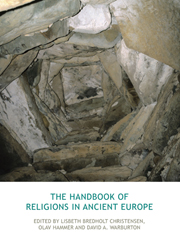Book contents
- Frontmatter
- Contents
- A note on Greek and Latin sources
- Abbreviations and short titles
- 1 Introduction
- PART I PREHISTORIC RELIGIONS
- PART II ANCIENT EUROPE IN THE HISTORICAL PERIOD
- 12 Minoan and Mycenaean religion
- 13 Etruscan religion
- 14 The religions of the Iberian Peninsula
- 15 Italic religion
- 16 Roman religion
- 17 Ancient Greek religion
- 18 The Graeco-Roman cult of Isis
- 19 The cult of Mithras
- 20 Religious Platonism: philosophy and religion in the Platonic tradition
- 21 Insular Celtic religion
- 22 Continental Germanic religion
- 23 Pre-Christian Anglo-Saxon religion
- 24 Old Norse religion
- 25 Slavic religion
- 26 Baltic religion
- 27 Religion in prehistoric Finland
- 28 Sami religion
- Timeline of key dates
- Contributors
- References
- Index
16 - Roman religion
from PART II - ANCIENT EUROPE IN THE HISTORICAL PERIOD
- Frontmatter
- Contents
- A note on Greek and Latin sources
- Abbreviations and short titles
- 1 Introduction
- PART I PREHISTORIC RELIGIONS
- PART II ANCIENT EUROPE IN THE HISTORICAL PERIOD
- 12 Minoan and Mycenaean religion
- 13 Etruscan religion
- 14 The religions of the Iberian Peninsula
- 15 Italic religion
- 16 Roman religion
- 17 Ancient Greek religion
- 18 The Graeco-Roman cult of Isis
- 19 The cult of Mithras
- 20 Religious Platonism: philosophy and religion in the Platonic tradition
- 21 Insular Celtic religion
- 22 Continental Germanic religion
- 23 Pre-Christian Anglo-Saxon religion
- 24 Old Norse religion
- 25 Slavic religion
- 26 Baltic religion
- 27 Religion in prehistoric Finland
- 28 Sami religion
- Timeline of key dates
- Contributors
- References
- Index
Summary
As far back as we can trace it, Roman religion was multi-cultural. Archaeological evidence demonstrates that in terms of religion and other cultural components early Rome was influenced by Etruscans, Greeks and even Carthaginians. It is thus illusory to believe that it is possible to remove different layers of foreign cultural influence and extract an original core of pure Roman religion: from the very beginning, Roman religion was a result of acculturation.
The significance of foreign cultural contacts and the perception that Roman religion was based on traditions that went back to before the foundation of the city are stressed in literary sources. The Aeneid, Virgil's national epic, tells the story of the Trojan hero Aeneas who escaped from burning Troy and sought safety in Italy. Bringing with him the house-hold gods (Penates) of his native land, Aeneas founded Lavinium and became a mythical ancestor of the Romans. Religion was also embedded in the foundation of Rome itself: when the twin brothers, Romulus and Remus, disputed which of them was to found the new city, the issue was settled by augury. Taking the auspices on the Aventine hill Remus saw six vultures; Romulus, however, observed twelve vultures flying across the Palatine hill and according to the tradition this was interpreted as divine approval of his founding of Rome, on 21 April 753 BCE (in our system of reckoning).
- Type
- Chapter
- Information
- The Handbook of Religions in Ancient Europe , pp. 192 - 207Publisher: Acumen PublishingPrint publication year: 2013



